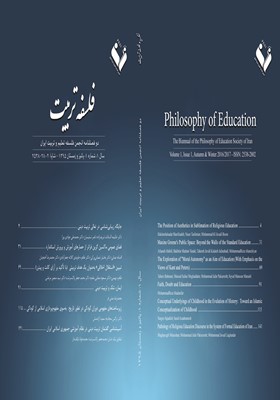The Position of Aesthetics in Sublimation of Religious Education
Subject Areas :
1 - دانشگاه مازندران
2 -
3 -
Keywords: Aesthetics, aesthetic perception, religious education,
Abstract :
Considering the fact that the existing approaches in determining the ultimate goals of the educational system are based on Islamic education, therefore, to explain this education and highlighting its potentials for promoting excellence are highly important in educational science research. The aim of this study is to explain the position of aesthetics and aesthetic perception in promoting sublimity and the realization of religious education.The research method is descriptive- analytical. The purpose of the analysis was to identify and pin down the relevant concepts and map the network of their relationships. For this purpose, first the concept of religiosity and religious education and its approaches were examined. Then, the concept of aesthetics and the nature of aesthetic perception and the theory associated with aesthetic perception and aesthetic education were introduced. Finally, the conceptual relationships peculiar to the special place of aesthetic sublimity in religious education were proposed and discussed. Results indicate that, based on the conceptual networks established between the components of religious education and those of aesthetics, the introduction of aesthetics components in the educative process could provide grounds for the enrichment of internal motivation, inner experience and moral obligation.Thus it seems that for the successful execution of religious education attention to aesthetics as an important part of axiology of education is a necessary condition over and above the art of pedagogy.
الیاس، جان (1385). تعلیم و تربیت (قدیم و معاصر). (عبدالرضا ضرّابی، مترجم). قم: مرکز انتشارات مؤسسهی آموزشی و پژوهشی امام خمینی (ره).
احمدی، بابک (1387). حقیقت و زیبایی، درسهای فلسفه ی هنر. تهران: نشر مرکز.
الهی، بهرام (1382). راه کمال. (فرزاد یمینی، مترجم). تهران: نشر جیحون.
الهی قمشه¬ای، حسین (1387). گلشن راز (شیخ محمود شبستری)، تهران: نشر علمی و فرهنگی.
باقری، خسرو؛ سجادیه، نرگس؛ توسلی، طیبه (1389). رویکردها و روشهای پژوهش در فلسفهی تعلیم و تربیت، تهران: نشر پژوهشکده ی مطالعات فرهنگی و اجتماعی.
باقری، خسرو (1384). نگاهی دوباره به تربیت اسلامی. تهران: انتشارات مدرسه.
جعفری، محمدتقی (1386). موسیقی از دیدگاه فلسفی و روانی. تهران: نشر مؤسسهی تدوین آثار علّامه جعفری.
حافظ نیا، محمدرضا (1386). مقدمهای بر روش تحقیق در علوم انسانی. تهران: انتشارات سمت.
رضایی، منیره (1384). تربیت زیباییشناسی به مثابه آموزش همگانی با تأکید بر آراء برودی. نشریه گفتوگو، 17، ص 33-13.
سجادی، سید مهدی (1384). تبیین و ارزیابی رویکرد عقلانی به تربیت دینی. فصلنامه ی نوآوریهای آموزشی، 11(4)، صص 55-35.
شاملی، عباسعلی (1381). درآمدی مفهوم شناختی در قلمرو تربیت دینی. فصلنامه ی روششناسی علوم انسانی، 32، صص 33-4.
شپرد، آنا (1386). مبانی فلسفی هنر. ترجمه ی علی رامین، تهران: نشر علمی و فرهنگی.
شریفزاده، حکیمه السادات، باقری، خسرو، امیری، هادی (1392). بررسی ماهیت تجربهی دینی از دیدگاه آلستون و کاربرد آن در تعلیم و تربیت، فصلنامه ی نوآوریهای آموزشی، 48(12). صص 26-7.
غزالی، امام محمد (1374). کیمیای سعادت، ب کوشش حسین خدیو جم، تهران: انتشارات علمی و فرهنگی.
طیب حسینی، سید محمود (1392). پژوهشی در معنای واژه قرآنی خشيت و تفاوت آن با خوف، دوفصلنامه كتاب قيم، 3(7)، بهار و تابستان.
کارول، نوئل (1387). درآمدی بر فلسفهی هنر. (صالح طباطبایی، مترجم). تهران: نشر فرهنگستان هنر.
کالینسن، دایانه (1385). تجربهی زیباشناختی. (فریده فرنودفر، مترجم). تهران: نشر فرهنگستان هنر.
کرس ول، جان دبلیو (1391). طرح پژوهش رویکردهای کمی، کیفی و ترکیبی. (علیرضا کیامنش، مریم دانای طوس، مترجمان). تهران: نشر جهاد دانشگاهی.
لاهیجی، شمسالدین محمد (1381). مفاتیح الاعجاز فی شرح گلشن راز. تهران: نشر علم.
محمد شریف احمد بن الهروی (1363). انواریه. (ترجمه و شرح حکمة الاشراق سهروردی، به کوشش حسین ضیایی، آستیم). تهران: انتشارات امیرکبیر.
نقیب زاده، عبدالحسین (1391). درآمدی به فلسفه. تهران: نشر طهوری.
هاسپرس، جان؛ بیزدلی، مونروسی (1387). تاریخ و مسائل زیبایی شناسی. (محمد سعید حنایی کاشانی، مترجم). تهران: انتشارات هرمس.
Bresler, L. (2002). Harry Broudy on the cognitive merits of music education: Implication for research and practice of arts curricuIum. Art Education PoIicy, 103(3): 17-22.
Broudy, H. S. (1987). The role of imagery in learning. LosAngles: The Getty Center for Education in the Arts.
Green, M. (1994). Active learning and aesthetic encounters: Talk at the Lincoln Center Institute. New York: NCREST.
Groossman, W. (1971). Aesthetics and Problems of educaonti, in A. Ralph (ed.), Schiller’s Aesthetic Education. Urbana: University of Illinois.
Phenix, Philip, H. (1971) The Aesthetic realm of meaning, in A. Ralph (ed.), The Aesthetic and Problems of Education, U.S.A, University of Illinois Press.
Rettig, P. R. & Janet, L. (1999). Linking brain research to art. Journal Articles; Reports Descriptive, 52(3):19-24.


